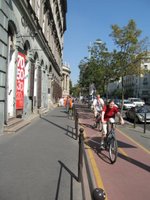Water Agreement: I held the public meeting Monday night and there were about 50 people in attendance, including trustees from many of the Lucas County townships. Jim Shaw, the county's director of public service, and Bob Williams, from the City of Toledo, were present to explain the agreement, the service area and answer any questions.
There was an overview of the agreement, including the summary of conditions that staff had put together. It was about a 10 minute presentation and then Jim took questions from the audience. Several questions were referred to Mr. Williams and most were answered. There were a couple of issues where neither individual had definitive answers or where the answer was dependent upon interpretation. Mr. Shaw promised to have definitive answers prior to the BCC vote the next morning.
After the Q&A, I asked what was the preference of the group. One individual said that the agreement should be signed. Everyone else said that the agreement should either be rejected or delayed for more input or more negotiations over the terms.
Tuesday morning, there were emails from three of the five townships impacted by the agreement formally asking the Commissioners to delay the vote. (The letters and the audio from the BCC meeting are available here.) Swanton and Richfield Townships wanted to have more opportunity to discuss the terms and conditions. Providence Township wanted time to hold a public meeting in Providence to have county and city representatives explain the agreement to their residents. The emails were sent to all three commissioners and I presented the requests at the meeting.
My colleagues did not believe there was any need to delay the vote and, after several legal clarifications on the language, the agreement was approved 2-1. I voted no.
My impression on this is one of amazement. Tina Skeldon Wozniak is usually one for allowing input and reaching consensus. According to the trustees, she never even discussed this agreement with any of them. I also don't understand the rush - especially considering the fact that the agreement was being circulated among the commissioners for signature without a vote. Had I not asked if they'd voted on this while I was in Hungary, it would have been signed and applied without ever coming before the BCC. Upon realizing that it needed a vote before being signed, it got scheduled for the next meeting (9-26). While the townships received a copy of the agreement late July/early August, there was no request for comments or deadline for input.
As I said at the Monday meeting, this is a terrific agreement for the City of Toledo and I understand them wanting such terms. But agreements are supposed to be about negotiation and mutually acceptable terms - and that's not what happened with this contract. Toledo put their terms to paper and the BCC accepted them without any input from those directly impacted.
Comm. Wozniak said that other options for water supply would have cost more money. The comments at my meeting indicated that perhaps paying more money would have been a better alternative than complete control by Toledo. She also said that this was better than requiring annexation - but many at the meeting felt that annexation wasn't necessary if you've already got control of the townships through the terms of the agreement.
Comm. Gerken said that the townships don't have to participate. But then what's the purpose of an agreement if none of the townships participate? Just to say you have a piece of paper?
Anyway, with this agreement signed, the townships can certainly enter into agreements with other sources for water in their jurisdiction, but the County would not be allowed to be involved. The agreement limits us to providing ONLY City of Toledo water until 2024 and there is no option for the County to get out of the agreement...the agreement can only be terminated by MUTUAL agreement - and that's the first time I've seen such a restrictive clause on any county contract.
Considering the total lack of logic and the rush, I can't help but believe that there is something else going on - I just don't know what it is. But I'm sure that, if true, one day soon something will be reported and we'll all go "a-ha!"
Arena Project: We held the first public hearing on the arena project Tuesday night at the McMaster Center in the downtown Library. (I love this venue for a presentation/meeting!) The powerpoint presentation and accompanying talk was very well done - more focused on the sight selection than the finances, but most of the aspects of the report were covered.
 There were, throughout the evening with people coming and going, 47 individuals who attended. However, 28 of those were elected officials and their staff, candidates/campaign staff, media, individuals involved with the project (The Collaborative, p.r. firm), or plan commission members/staff. I was disappointed that only about 19 individuals from the general public were there.
There were, throughout the evening with people coming and going, 47 individuals who attended. However, 28 of those were elected officials and their staff, candidates/campaign staff, media, individuals involved with the project (The Collaborative, p.r. firm), or plan commission members/staff. I was disappointed that only about 19 individuals from the general public were there.There was a period for Q&A and several times, individuals were refered to the full report - and the exhibits - for more detailed information. In general, the questions were about my colleagues' votes on city council for the arena in the marina district and the "keeping the arena on the East Side" issue, availability of parking downtown versus the ease of parking at the current Sports Arena, and the projected size not being big enough in terms of fixed seating.
The really interesting comment was when Comm. Gerken said he'd talked to Sen. Randy Gardner about being able to impose the increased hotel-motel tax in Wood County since those hotels would also benefit from a downtown arena and that "Sen. Gardner was not opposed" to that idea. Fred LeFebvre, from WSPD, asked Rep. Peter Ujvagi (who was the only state rep to attend) if he'd be supporting the bill to increase the tax in Columbus. Rep. Ujvagi replied yes - especially if it would apply to both Lucas and Wood County.
Of course, this got covered on the radio the next day with Sen. Gardner clarifying that he's certainly OPPOSED to such an arrangement and that the chances of something like that passing the legislature was 0%. (This made the second time in two days that Sen. Gardner had to clarify his position based upon comments from Comm. Gerken.) Rumor has it that Comm. Gerken also sent out email clarification that Lucas County is not interested in collecting additional hotel-motel taxes from Wood County...
Additionally, I received a letter from a large number of hotel-motel owners stating that they are opposed to the idea of increasing the hotel-motel tax to fund an arena. Interestingly, according to them, Monclova's total taxes on rooms would be the highest in the nation if such an increase were passed. I will keep you posted on further developments.












































